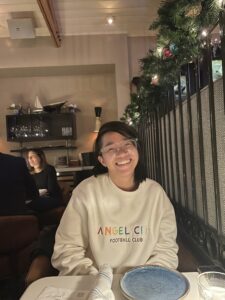Having grown up in Texas, Hannah Koester felt distant from China — her birth country — and her cultural heritage. Her Mennonite faith has helped her feel safe to explore what it means to be Chinese.
This blog post is in celebration of Asian American and Pacific Islander (AAPI) Heritage Month, which runs through the month of May.
 Hannah Koester, or “HK”, is originally from China, by way of Texas. She currently lives in Pasadena, California, and attends Pasadena Mennonite Church. She enjoys attending vigils for Palestine on Monday nights with her community, playing Dungeons and Dragons (DnD) with her roommates and going to see shows/concerts around Los Angeles with friends.
Hannah Koester, or “HK”, is originally from China, by way of Texas. She currently lives in Pasadena, California, and attends Pasadena Mennonite Church. She enjoys attending vigils for Palestine on Monday nights with her community, playing Dungeons and Dragons (DnD) with her roommates and going to see shows/concerts around Los Angeles with friends.
____________________________________
I was invited to write this blog post to highlight Asian American and Pacific Islander (AAPI) Heritage Month and how my cultural heritage informs my faith as a Mennonite. It feels ironic in a sharp way, because I was adopted from China and raised in Texas, separated from my own cultural heritage, language, land, ancestors and people. Even as I try to relate my faith to my heritage, all I can think about is how I don’t relate to my “own” cultural heritage and how I’ve had to find a way back to myself that includes my “Chinese-ness.”
When I think of my cultural heritage, I think of an orphanage called Nanning Social Welfare Institute. I think of how my first name is actually just the symbol for “institution,” like a hospital or international center. I think of how so much of my Chinese-ness is tied to sporadic memories and distant longings.
In a similar way, when I think of my faith before joining the Mennonite church, I think of a spiritual orphanage called the evangelical church, which raises “sons and daughters” with scarcity and poverty mindsets. I think of broken structures that could not provide what they said they would. Structures in which love was not given freely but had to be earned, and the reality of being chosen meant one could be un-chosen.
My spiritual orphanhood led me to the Mennonite faith, by way of mysticism, contemplation and a spirituality for those who have lived through hell. This Mennonite faith has introduced me to a family. I’ve met other spiritual orphans, healing from broken worldviews and searching for a God who could hold the confusion and grief that reconciling theology and theopraxis often brings. As we’ve grown together and imagined together, these ties have strengthened and deepened into a family, not by blood but by choice, as we walk/protest/hope together toward a more beautiful world that we can joyfully live in.
My Mennonite faith informs my cultural heritage. In it, I have found a safe space to explore what being Chinese means to me. I have been able to rewrite old paradigms with new ideas of self.
This chosen family cannot and does not replace what I lost, but they do give me the courage to look into my past and find belonging.
I’ll end with a short story: This past Wednesday, April 24, some friends hosted a Seed Party, as a part of the Coalition to Dismantle the Doctrine of Discovery, in which we exchanged seeds and shared about what seeds mean to us. A Maya man spoke about his land, culture and identity, as well as how his people experienced displacement from their land. It resonated deeply with me, and I felt his story in my bones — the lived experience of separation and loss, in service to accumulation and wealth of the dominant-affluent.
It reminded me of the research I had been doing into Indigenous cultures of China, and more specifically my “hometown” and the group I could potentially belong to, the Zhuang people. I felt a sense of oneness and home with myself, in a way I hadn’t experienced before when I had tried to learn more about my past. That night invigorated me to continue pursuing my cultural heritage, and it showed me how my faith honors it.
The views and opinions expressed in this blog belong to the author and are not intended to represent the views of the MC USA Executive Board or staff.
Interested in submitting a blog for Menno Snapshots? Please see our blog guidelines here.

